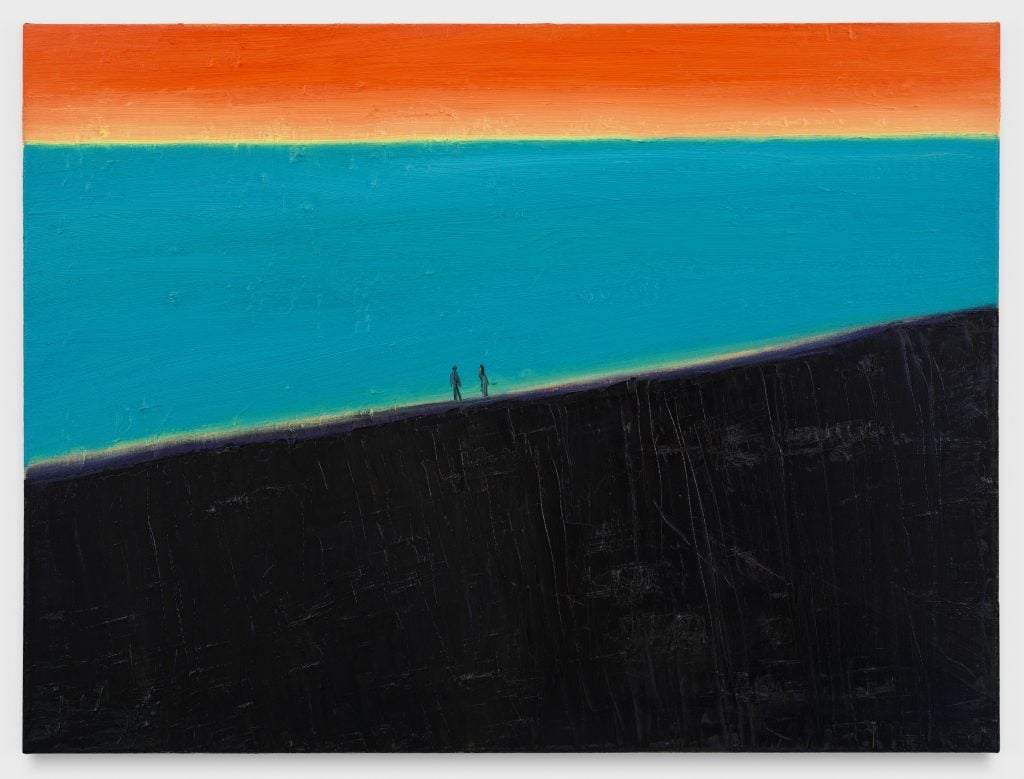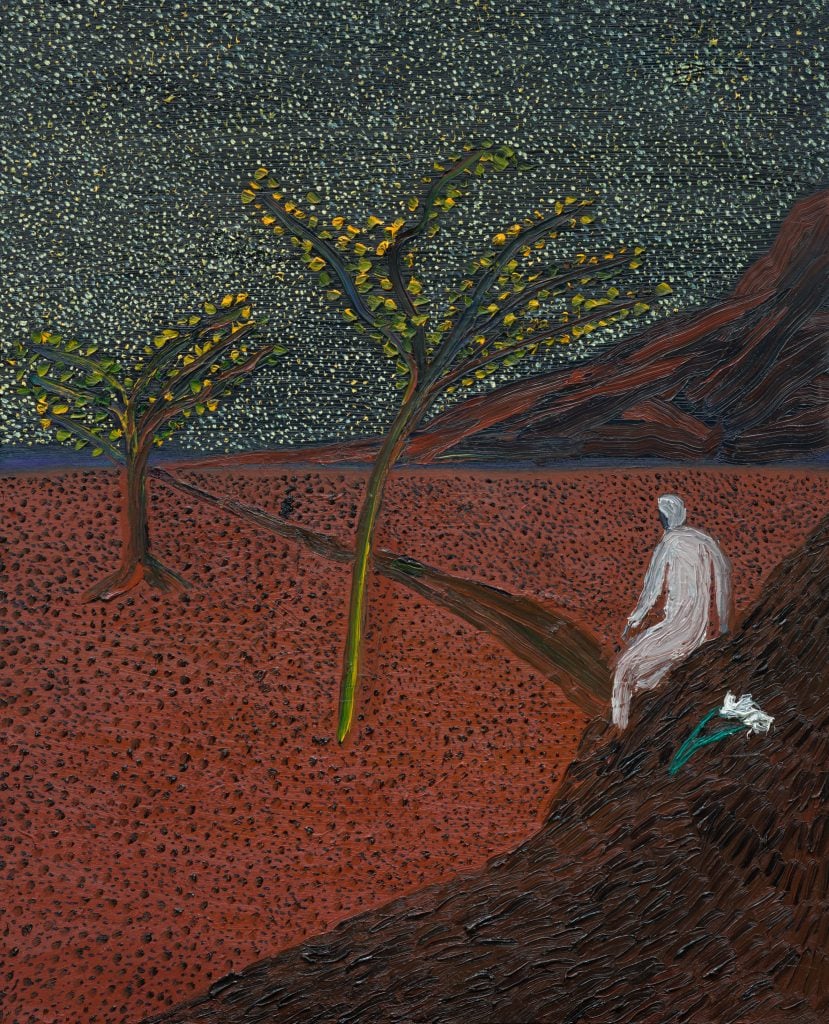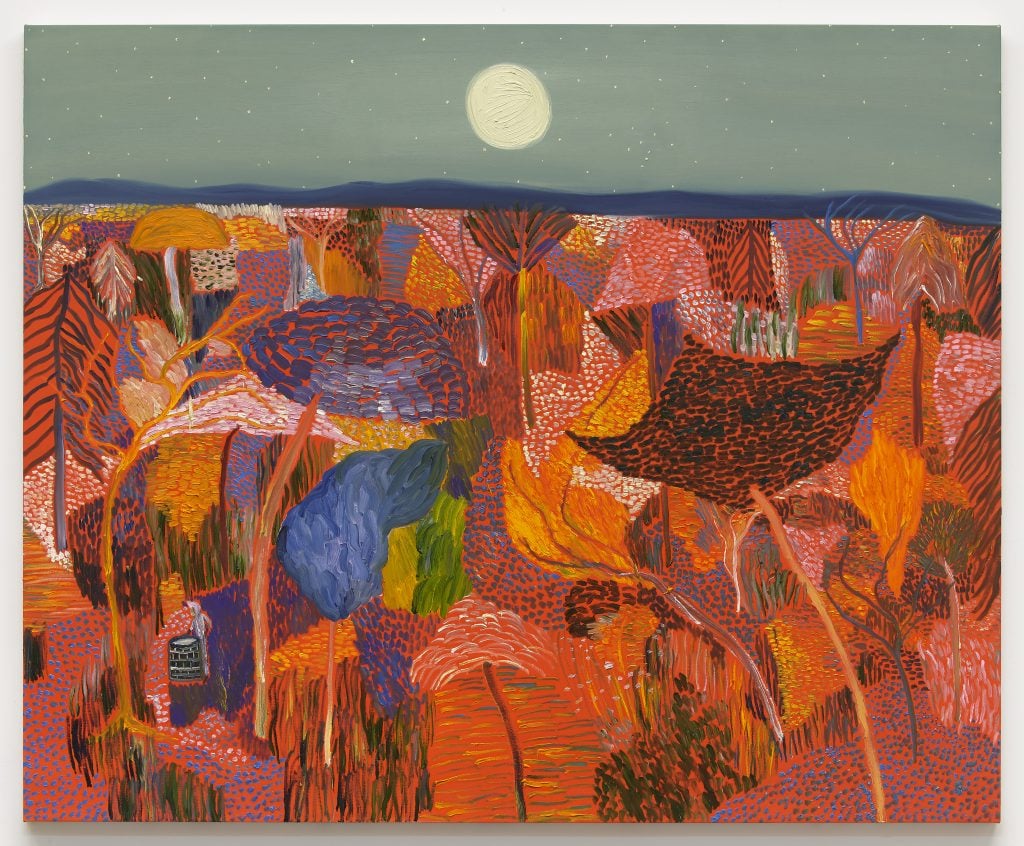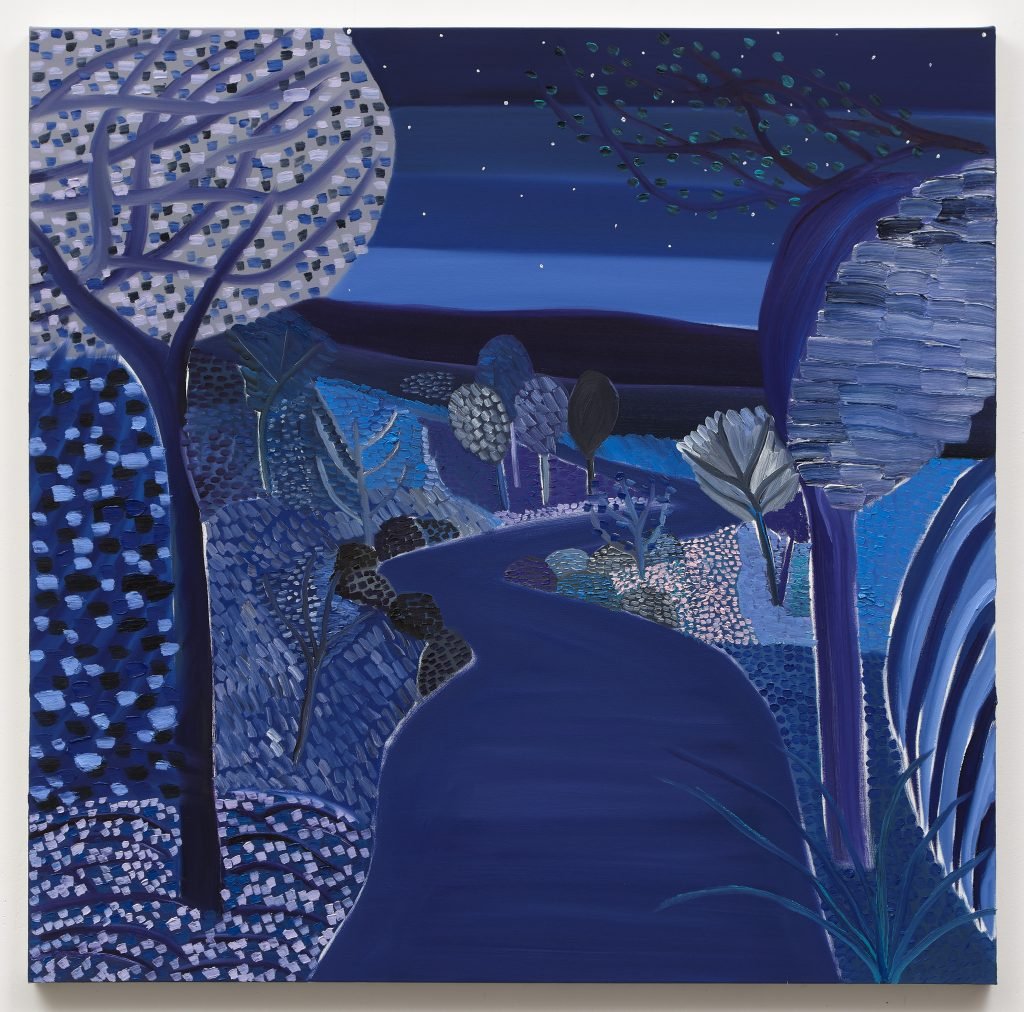Art Criticism
Matthew Wong’s First Museum Retrospective Cements the Tragic Artist’s Reputation as a Master of Melancholy Style
“The Realm of Appearances” is on view at the Dallas Museum of Art, through February 19, 2023.

“The Realm of Appearances” is on view at the Dallas Museum of Art, through February 19, 2023.

Barry Schwabsky

Just one of Matthew Wong’s paintings entered a museum collection during his too-short life. He’d sent his 2017 painting The West to the Karma gallery booth at that year’s Dallas Art Fair. It depicts a white-clad figure sitting on a hillside next to a pair of tossed-aside flowers and gazing back, away from the foreground, toward a vast, flat terrain marked only by a pair of trees and a road leading inexorably into the distance—perhaps Wong’s movie-bred image of the Texas landscape.
After arriving in Dallas, he realized he was dissatisfied with the painting. He furiously reworked it on the fair’s installation day, adding the impossibly dense field of stars that now populates its night sky—a multitude of tiny bright marks echoing the somewhat less densely packed dabs of black paint that dot the red earth landscape below. And it’s this prodigiously bespangled heaven that Wong added, looming above the landscape’s lonely witness, that gives the painting its intensity—its visionary quality, if that’s quite the right word for an effect that is as much tactile as it is visual.
In any case, when the Dallas Museum of Art’s curators visited the fair later that day, they must have been just as struck by this strange, fervent painting—somehow at once ecstatic and melancholy—as I remain today. The museum disposes of a fund specifically earmarked for purchases from the fair, and they used it to acquire this painting by an essentially unknown Canadian artist, whose solo shows to date, of very different work, had been in Hong Kong (where he’d spent part of his childhood) and Zhongshan, China.

Matthew Wong, The West (2017), oil on canvas, Dallas Museum of Art, Dallas Art Fair Foundation Acquisition Fund. Photo: © 2022 Matthew Wong Foundation/Artists Rights Society (ARS), New York.
His closest connection to the American gallery scene had come through participation the previous summer in a pop-up group show curated by Matthew Higgs, director of New York’s venerable alternative space White Columns, in the Hamptons. The show was organized under the auspices of Karma, the gallery that was now trying him out at the Dallas Art Fair. In any case, the paint on the upper portion of The West was still wet when it entered the DMA collection.
So, it’s appropriate that the first U.S. museum show of Wong’s work (and the second, following a previous exhibition at the Art Gallery of Ontario, since the artist’s death by suicide in 2019) should take place at the Dallas Museum of Art, where it is on view through February 19, 2023. The show, curated by Vivian Li and titled “The Realm of Appearances,” charts Wong’s breakneck development.
Having taken an MFA in photography in 2012, he quickly grew dissatisfied with the camera, and began teaching himself drawing and painting. The earliest works in this exhibition—drawings from 2014, paintings from 2015—show the artist finding his way, experimenting (sometimes awkwardly) with materials. But Wong was already set on the subject matter that would occupy him for the rest of his life: Landscape, and the very small part an individual human plays in the cosmos.
In the rare instances where Wong focuses, portraitlike, on the human head, as in the diptych Banishment from the Garden, 2015, the face is practically effaced. In an untitled ink drawing from 2015, for example, a head is obscured by a bluntly brushed glyph. In the distant background of another work depicting what seems to be a birch forest—wonderfully, the spaces between trunks are also trunks—a tiny figure observes another who occupies the foreground; I believe this represents the same person observing him- or herself as if from afar.

Matthew Wong, The Realm of Appearances (2018), oil on canvas. Private Collection. Photo: © 2022 Matthew Wong Foundation/Artists Rights Society (ARS), New York.
By 2017, Wong had mastered his personal art style, which might be described as a synthesis of Fauvism, folk art, and (as a Western viewer like me gleans from the excellent catalogue) the “new ink” painting movement that took root in Hong Kong in the 1960s. He pressed almost to the breaking point his propensity for the “contradictory spaces” he admired in the work of Willem de Kooning, or what Lesley Ma, in the catalogue, calls “constructions bordering on the awkward,” with inharmonious juxtapositions of patterns and forms and strange manipulations of scale.
One of his favorite motifs—you might even call it archetypal—is the road or path stretching away into the distance. Its goal is always invisible. But the road never just runs through the landscape; it divides the terrain, breaks it into parts. In the late Path to the Sea (2019), for instance, the grayish-blue road seems to float entirely detached from the forest to its left and right; it is not of the same world.
In a work such as The Kingdom (2017)—another birch forest image—Wong seems to be trying to include as many different kinds of mark as possible; it’s the overall distribution of their disharmony that gives the painting its paradoxical unity, a unity that presents a nervous, even agitated surface yet maintains an inner equilibrium. The ruler of this kingdom is a minute crowned figure ensconced in an arched, freestanding niche, almost unnoticeable yet at the center of everything. I couldn’t help but wonder whether Wong, a poetry lover, might have been thinking of the melancholy speaker of Charles Baudelaire’s “Spleen III”: “I am like the king of a rainy country, Rich but powerless, young and yet very old.”

Matthew Wong, River at Night (2018), oil on canvas. Collection of Shio Kusaka and Jonas Wood. Photo: © 2022 Matthew Wong Foundation / Artists Rights Society (ARS), New York.
But hyperactive compositions like The Kingdom were never Wong’s only option. The Wish (2016), a deep blue nocturne illuminated only by the thinnest sliver of a yellow moon, shining on a tiny figure making its way across a mountain path, shows he was always ready to leave everything out rather than cram everything in. In some of his final works from 2018–19, he began to do that more often, most notably in the immensely pale, nearly monochromatic Morning Mist (2019), a pure landscape filled with details that emerge only with breathtaking slowness.
Also at this time, interior spaces and still-life began to occur more frequently, but always with a view onto the outside. The single delicate flower in a water glass that is the ostensible subject of Blue Night (2018) seems merely to relay a message sent more insistently by the gloriously flowering orange tree that blazes in the window at the upper right. That vivid yet ambiguous message is the essence of Wong’s art.
“The Realm of Appearances” is on view at the Dallas Museum of Art, through February 19, 2023.